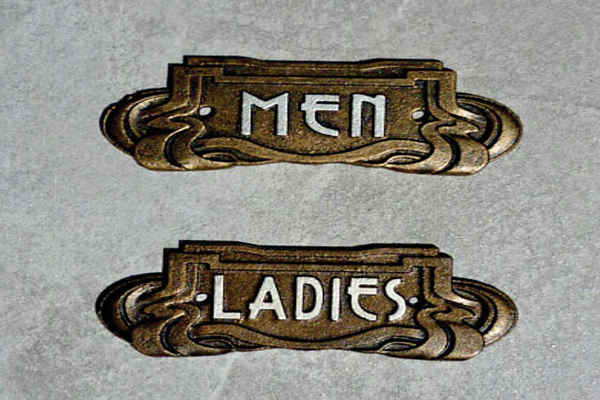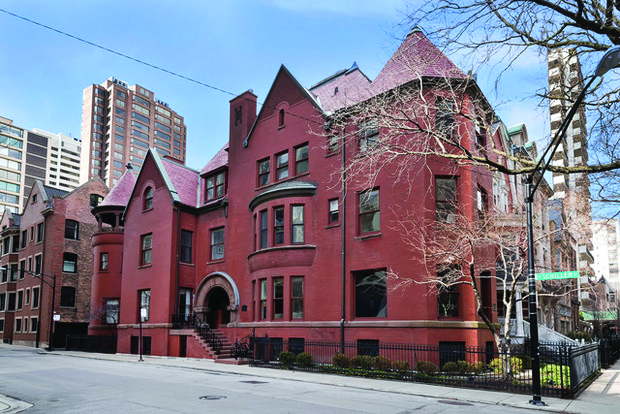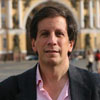Nouveau Sites in Art Nouveau
Art Nouveau (“New Art”) is an all-encompassing European style of architecture,

(Photo Caption: Art Nouveau in UNUSUAL Places)
furniture, home décor, glass design, jewelry, posters and is even seen on clothing. Art Nouveau is composed primarily of flowing curved organic designs that are so florid – that flowers are an actual motif that is widely used. Its creative time span was roughly from 1890 to 1914 – the start of WWI. It’s the antithesis of “angular” – and frequently looks as it its designs were poured out of a pastry tube.
Within the History of Architecture Art Nouveau follows the numerous imitation historical styles of the 19th century including Neo-Classical, Neo-Gothic, Neo-Moorish, Neo- Renaissance, Neo-Baroque, Neo-Everything. Like a controversial politician – Art Nouveau has been called many names. In the US it was frequently referred to as the “Tiffany Style.” “No, not named after a president’s daughter but named after “Louis Comfort Tiffany.” Yes, that Tiffany from Tiffany’s jewelers. And as is the case with Tiffany Lamps – stained glass was one of the manifestations of the Art Nouveau movement.
Art Nouveau lovers have likely already visited the more famous Art Nouveau cities – Brussels where the aesthetic movement started with Victor Horta. Barcelona and it’s somewhat gaudy (Antonio) Gaudi “Modernismo” (Spanish “Art Nouveau”). And of course, Paris — where Art Nouveau was coming and going all over the city especially since the Paris Metro entrances were designed by the great Hector Guimard.
Stunning examples of Art Nouveau are also found in Budapest where it’s called “Secessionist” – a name which sounds as if the style belonged to our Confederacy. And Prague the home of Art Nouveau’s great Alfons Mucha whose home is an outstanding Art Nouveau museum. What do Budapest and Prague Art Nouveau have in common? Those two cities — which were in the Hapsburg Empire — are derived from the Secessionist Architecture of the capital of the Hapsburg Empire – Vienna. (Mucha was so well-known beyond that empire you can see his store interior, Boutique Fouquet, in one of my favorite Paris Museums – the newly-restored Museum Carnavalet – the Museum of the City of Paris.)
While the three most popular European tourist destinations, London, Paris, and Rome are cultural centers and capital cities – surprisingly, with the exception of Paris, they’re not well known for their Art Nouveau. If you venture out from those capital cities — you can see very unusual and distinctive Art Nouveau styles while avoiding the crowds and lines of the capitals. Therefore, let’s visit my three less-well known favorite Art Nouveau Cities within Great Britain, France and Italy: Glasgow, Scotland; Nancy, France; and Turin, Italy.
Edinburgh is Scotland’s biggest tourist magnet – and justly so. However, to visit Great Britain’s most famous Art Nouveau city – take a local train an hour west to Glasgow. My favorite “Mac” is another form of “Apple” –- Charles Rennie Macinstosh — Britain’s best known “Art Nouveau” architect and designer. Macintosh’s style is much less florid and more angular than his contemporaries. It’s derived from William Morris’ Arts and Crafts movement. In fact, it’s similar to another famous contemporary architect — America’s Frank Lloyd Wright. In fact, if you look at a Macintosh designed chair and a Frank Lloyd Wright chair – it’s sometimes difficult to tell them apart. (Speaking of “apart” — Macintosh and Wright were born one-year apart Macintosh (1867), Wright (1868).
British Art Nouveau was first called, “The Modern Style” but due to the prominence of Charles Rennie Macintosh in Glasgow – it soon became known as the “Glasgow School” – which really lives up to its name since Macintosh’s most famous building is a school – the Glasgow School of Art. And if you’re as enchanted with that school – leave it the Macintosh to design yet another school – the State Street School – which is the Museum of Education. In fact, Macintosh himself also comes in doubles. Charles Rennie Macintosh’s wife is the great Art Nouveau artist, Margaret Macdonald who collaborated on many of her husband’s projects.
There’s another great “British” Art Nouveau artist, who studied at the St. Petersburg (Russia) Imperial Academy of Art, painted in London, who happens to be an American — James MacNeil Whistler. While in Glasgow, pay a visit the Hunterian Museum which has the greatest number of Whistler paintings in the world. (FYI: If you want to see Whistler’s gorgeous Art Nouveau décor – visit his “Peacock Room’ – it’s only a few blocks from the White House in the Corcoran.) While at the Hunterian visit its Macintosh/Macdonald rooms – and you’ll see their genius immersed in fully-decorated residential rooms for the “total” Macintosh experience.
If you’re hungry between visits to the great architecture and design of the Macintoshes in Glasgow — you can even dine with the Macintoshes — at the Willow Tea Room – a restaurant that takes your breath and appetite away. The only thing missing was a Macintosh Apple Pie for dessert.
One of my favorite cities in France isn’t near Paris or its environs and it’s not in Provence or on the French Riviera — it’s Nancy – which is east of Paris in the province of Lorraine. Nancy has a split personality. Its planned Baroque center is dominated by the exquisite Place Stanislas, one of the most beautiful squares in Europe. However, it’s the district enroute from the train station — walking toward the center — that has one of the most amazing concentrations of Art Nouveau buildings in Europe.
Unlike other Art Nouveau cities — in which architects designed and builders constructed to their architect’s specifications — in Nancy local glass and furniture manufacturers joined together in 1901 with architects to create and design their own style of Art Nouveau unique to Nancy known as “Ecole de Nancy” – “School of Nancy.” (Just as Glasgow’s unique style was named after that city.)
The two main School of Nancy Art Nouveau designers were Emile Galle – whose family owned a local glass factory and Louis Majorelle — whose family owned a local furniture factory. Together, with architects, they constructed an entire district of Art Nouveau apartments, hotels, banks, department store, etc. You name it – it was built in Art Nouveau and filled with Art Nouveau decorative objects – even Art Nouveau toilets. And if you can’t live without Art Nouveau – visit the local cemetery with its Art Nouveau mausoleums and tombstones.
One of the most stunning examples of School of Nancy Art Nouveau is the home of Louis Majorelle — everywhere you look you’ll see everything Art Nouveau – even embroidery on towels and pillowcases. Plants and flowers decorate everything – not the real flowers in pots – but the artistic depiction abounding in decoration everywhere you look. The Majorelle Villa has more curves than Marilyn Monroe. (If the name, “Majorelle” sounds familiar, the famous Villa Majorelle and garden in Morocco was the home of Louis Majorelle’s son. No, it’s not in Art Nouveau.)
It’s only fitting that Nancy has a museum dedicated to Art Nouveau – “Musee Ecole de Nancy” – with all the furniture and objects designed by Emile Galle, Louis Majorelle and the rest of the Nancy gang. Just as in Glasgow – top off your Nouveau Art Nouveau city with a visit to a magnificent Art Nouveau restaurant – the Brasserie l’Excelsior — with its cavernous main dining room.
And if you’re heading back to Paris – two of my favorite Paris restaurants are Art Nouveau. One of the stars of the turn of the last century’s operetta, “The Merry Widow” (where the widow got even merrier) is – Maxim’s. While there, visit Pierre Cardin’s seldom-visited stupendous Art Nouveau museums upstairs. You can miss a train – but you can’t miss the elegant Art Nouveau restaurant in Paris’ Gare de Lyon train station (yes, a train station) — “Le Tren Bleu” – which coincidentally is the name Bloomingdale’s took for its restaurant.
And now on to Italy. If Florence is the “Birthplace of the Renaissance” then Turin is the “Birthplace of Italian Art Nouveau” – which is called, “Liberty Style” – named after the London’s Liberty department store which was the bastion of Art Nouveau textiles and home furnishings. Here’s the irony: Italian Art Nouveau named after a British store but not British Art Nouveau. Maybe the next great architectural style in Britain will be named after an Italian department store.
Nancy’s Art Nouveau grew around joint cooperation of different decorative artisans in 1901 — while the following year — 1902, the first International Exposition of Modern Decorative Arts was held in Turin to spread the popularity of Art Nouveau. (Just as the more famous — Paris’ 1925 Exposition des Arts Decoratifs — was the catalyst for promoting Art Deco.)
While the stars of Glasgow’s Art Nouveau were Mr. & Mrs. Charles Rennie Macintosh — and Nancy’s stars were Emile Galle and Louis Majorelle — Turin had its own star – the architect Pietro Fenoglio. Fenoglio designed over 300 Art Nouveau buildings in and around Turin — including what many consider the ideal Italian Art Nouveau building – his own home — the Casa Fenoglio-LaFleur.
Turin’s main Art Nouveau street is Corso Francia. In fact, the entire district around Corso Franca – Zona Francia — is Art Nouveau. Art Nouveau is so pervasive in Turin that there are other Art Nouveau sections such as Zona Crocetta. In Turin Art Nouveau wasn’t just for the rich — a nearby district — Leumann Village – has an entire working-class district with one of the few Art Nouveau churches in Italy.
Unlike Glasgow and Nancy, I’m not going to recommend a favorite Art Nouveau restaurant. I’m going recommend my three favorite Turin Art Nouveau restaurants, Café Torino, Baratti & Milano and Café Mulassano.
Before we leave Italy, I’d like to recommend another site that is actually three totally different sites in one. It’s the Villa Torlonia in Rome. It was Mussolini’s home which is ironically situated over a Jewish Catacomb – with one of my favorite “Liberty Style” Art Nouveau buildings – the “Owl House.” And even Rome has an entire Art Nouveau distric — Coppede.
Now the piece de resistance for Art Nouveau lovers – the city that has more Art Nouveau than any other city in the world. Riga, Latvia. During the period of Art Nouveau before WWI, Riga was a thriving port on the Baltic – part of the Russian Empire. Glasgow basically has one style of Art Nouveau – refined and less ornate while Nancy and Turin excel at the more decorative Art Nouveau where even iron and glass bend to the architects’ and designers’ will becoming fluid and florid.
Unlike the other three cities, Latvia has many different types of Art Nouveau from the elaborate, curvy and florid of Nancy and Turin to the more subdued of Glasgow. In fact, Riga has four different categories of “Latvian Art Nouveau”: Eclectic. Perpendicular. National Romantic, and even Neo-Classical. Many of Riga’s architects were of German origin and therefore we should use the German term for “Art Nouveau –”Jugenstil” (“Young Style”). However, since it was under Russian control, I prefer the Russian name, “Style Moderne.”
On my first visit to Riga, I found Riga’s Art Nouveau– besides being totally different from the Art Nouveau in Glasgow, Nancy and Turin –totally different from what I had expected. Many of Riga’s later Art Nouveau buildings had more straight, balanced lines of horizontal and verticals – elements of Art Deco – than they had Art Nouveau’s fluid, floral swerves, curls and curves. In fact, I discovered so many Early Art Deco/Art Nouveau buildings that I even coined a new term, “Proto-Art Deco.” I reported on my architectural findings in a lecture for the Latvia Consul General for members of the United Nations.
In another lecture — “The Romanovs and the Jews” — I even showed examples of the Russian Jewish architect Mikhail Eisenstein’s extravagant Art Nouveau buildings in Riga. If the Eisenstein’s name sounds familiar – his son, Sergei Eisenstein — directed the Soviet epic, “October: Ten Days That Shook the World” – which filmed the storming of St. Petersburg’s Winter Palace.
While in St. Petersburg — after visiting the Winter Palace — cross the river via the Art Nouveau (“Style Moderne”) Trinity Bridge (a gift from France for the 200th anniversary of the founding of St. Petersburg) to an entire beautiful Art Deco district that blossomed (after the bridge’s opening) to another side of St. Petersburg missed by most tourists.
Since “Art Nouveau” was “Nouveau” back in the beginning of the previous century — maybe in the 21st century “Art Nouveau” should be renamed “Art Vieux” – “Art Old.” However, something passe (another French word) can still be eternally beautiful – except aging Hollywood stars with too much plastic surgery.





